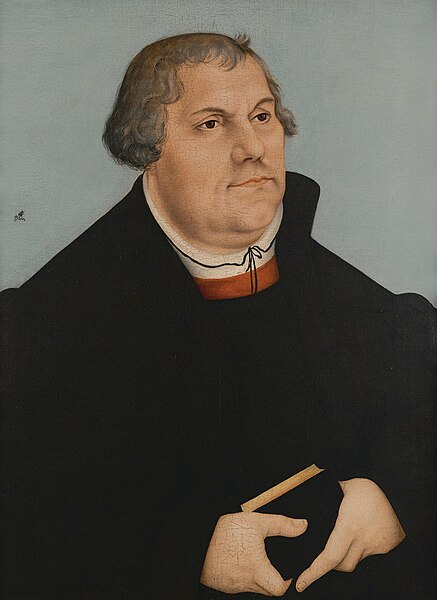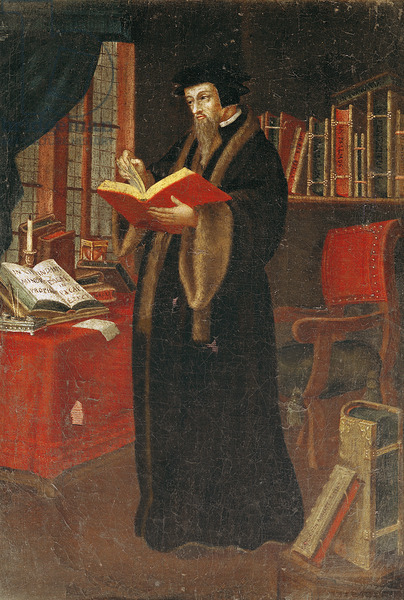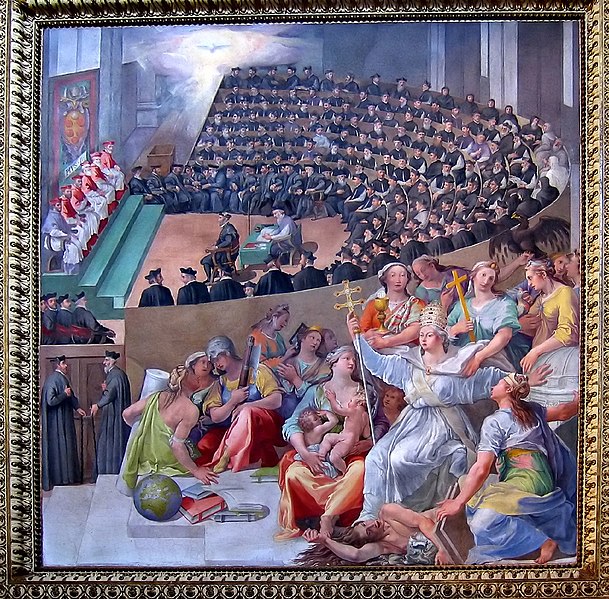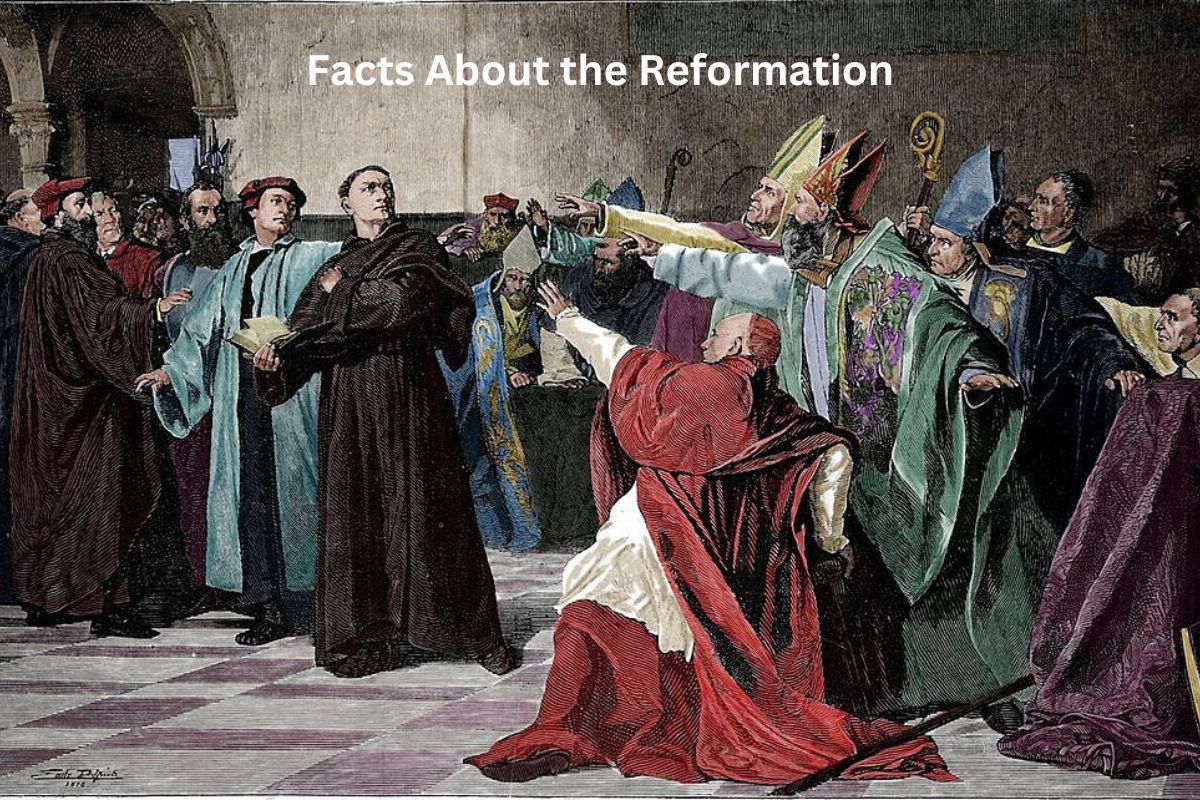The Reformation was a transformative religious and cultural movement that swept through Europe in the 16th century.
It began with Martin Luther’s defiant act of posting his 95 Theses in 1517 and gave rise to Protestantism, a diverse range of Christian denominations that challenged the authority of the Catholic Church.
The Reformation was not merely a religious schism; it also ignited religious wars, prompted the Catholic Church’s Counter-Reformation, and left a profound and enduring impact on Western culture, democracy, and religious diversity.
In this exploration, we will delve deeper into the key facts and consequences of this pivotal historical period.
Reformation Facts
1. Started in 1517 with Martin Luther’s 95 Theses

On October 31, 1517, Martin Luther, a German monk and theologian, posted his famous “95 Theses” on the door of the Castle Church in Wittenberg, Germany.
These theses were a list of grievances and theological challenges directed at the Catholic Church, particularly its practice of selling indulgences. Luther’s act of nailing the theses to the church door is often considered the starting point of the Reformation.
Also Read: Martin Luther Timeline
Luther’s main argument was that salvation could not be bought through the purchase of indulgences but was instead a matter of faith and God’s grace. His challenge to the Church’s authority ignited a theological debate that spread rapidly through Europe.
2. Led to the creation of Protestantism
Martin Luther’s ideas and criticisms of the Catholic Church gained widespread support among people disillusioned with the Church’s practices and perceived corruption.
Those who followed his teachings and beliefs became known as “Protestants,” a term derived from the Protestatio, a document issued by Lutheran princes in 1529 protesting against the Catholic Church’s decisions.
Also Read: Timeline of Protestant Reformation
Protestantism encompassed various theological and doctrinal movements, including Lutheranism, Calvinism, Anglicanism, and more. These new branches of Christianity had distinct beliefs and practices compared to the Catholic Church, leading to the fragmentation of Western Christianity.
3. Printing press facilitated the spread of Reformation ideas
The invention of the printing press by Johannes Gutenberg in the 15th century was a crucial factor in the success and rapid spread of Reformation ideas. Prior to the printing press, books and documents had to be painstakingly copied by hand, limiting their distribution.
With the printing press, Martin Luther’s writings and those of other reformers could be mass-produced and widely distributed. This allowed their ideas to reach a much larger audience, including common people who could now access religious texts and information in their native languages.
The printing press played a pivotal role in enabling the Reformation to become a mass movement, as it facilitated communication, debate, and the dissemination of religious literature throughout Europe. This technological advance contributed significantly to the Reformation’s impact and the subsequent spread of Protestantism.
4. John Calvin developed Calvinism

John Calvin, a French theologian and pastor, was a key figure in the Reformation. He developed a distinct theological system known as Calvinism, which became one of the major branches of Protestantism.
Calvinism emphasized several key beliefs, including the doctrine of predestination, which held that God had already chosen who would be saved and who would be damned before the foundation of the world. This doctrine had a profound impact on the religious thought of the time.
Calvin also promoted the idea of a disciplined and well-ordered church, often referred to as a “Presbyterian” system of church governance. This system involved the election of church leaders by the congregation, rather than appointment by bishops or clergy, giving congregants a more active role in church affairs.
Calvinism spread throughout Europe, particularly in Switzerland, the Netherlands, Scotland, and parts of France, leaving a lasting theological and ecclesiastical legacy.
5. Sparked religious wars across Europe
The Reformation triggered a series of religious conflicts and wars across Europe as different regions and rulers adopted either Protestantism or remained loyal to Catholicism. These conflicts were often intertwined with political and territorial disputes.
The German Peasants’ War (1524-1525) was one of the earliest armed conflicts associated with the Reformation. It was fueled by both religious and socio-economic grievances of the peasants.
The French Wars of Religion (1562-1598) were a series of conflicts between Catholics and Protestants in France, resulting in significant religious and political instability.
The Thirty Years’ War (1618-1648) was one of the most devastating conflicts, involving multiple European powers and resulting in widespread destruction and loss of life. It was primarily a war between Protestant and Catholic states within the Holy Roman Empire.
6. Catholic Church responded with the Counter-Reformation
In response to the challenges posed by the Protestant Reformation, the Catholic Church initiated the Counter-Reformation, also known as the Catholic Reformation, in the mid-16th century.
The Counter-Reformation aimed to address perceived shortcomings and abuses within the Catholic Church and to reaffirm Catholic doctrine and practices. It included efforts to improve the education and training of clergy, curb corruption, and clarify Catholic teachings.

7. The Council of Trent addressed Catholic reform
The Council of Trent (1545-1563) was a significant event during the Counter-Reformation. It addressed doctrinal issues, reaffirmed traditional Catholic teachings, and implemented various reforms. The council also emphasized the authority of Scripture and tradition in Catholic theology.
The Counter-Reformation succeeded in reinvigorating the Catholic Church and strengthening its position in many parts of Europe, while also intensifying the theological differences between Catholics and Protestants.
8. Resulted in religious diversity within Christianity
The Reformation resulted in the emergence of various Protestant denominations, each with its own distinct beliefs and practices. Some of the major branches of Protestantism include Lutheranism, Calvinism, Anglicanism, and Anabaptism.
Lutheranism, founded by Martin Luther, emphasized salvation by faith alone and the authority of the Bible. It became the dominant form of Protestantism in parts of Germany and Scandinavia.
Calvinism, founded by John Calvin, emphasized predestination and a disciplined church structure. It found adherents in Switzerland, France, Scotland, and the Netherlands.
Anglicanism, established in England under King Henry VIII and further developed during the reign of Queen Elizabeth I, retained many Catholic rituals and practices while adopting Protestant theology.
Anabaptism, a radical movement, rejected infant baptism, advocated adult baptism, and sought a more primitive form of Christianity. It led to the formation of various Anabaptist groups, such as the Amish and Mennonites.
9. Contributed to secularization and religious pluralism
The Reformation encouraged critical thinking and individual interpretation of religious texts. This emphasis on personal faith and conscience laid the groundwork for the development of secularism, which separates religious and governmental authority, and religious pluralism, which allows for the coexistence of multiple religious beliefs.
The questioning of religious authority and the emphasis on individual religious experience fostered a climate where religious diversity and freedom of belief became more accepted. This paved the way for the development of diverse religious landscapes in modern societies.
10. Left a lasting impact on Western culture and religion
The Reformation had a profound and lasting impact on Western culture and religion. It played a significant role in the development of modern democracy and the concept of individual rights.
It contributed to the spread of literacy as people sought to read religious texts and interpret them for themselves. This, in turn, had broader implications for education and the rise of the Enlightenment.
The Reformation also influenced art, music, and literature. Artists like Albrecht Dürer and composers like Johann Sebastian Bach were influenced by Reformation themes and ideas.
It laid the groundwork for religious liberty and tolerance by challenging the notion of a single, state-mandated religion. This, in turn, contributed to the idea of the separation of church and state.
The Reformation also had a significant influence on the colonization of the Americas. For example, the Pilgrims who settled in Plymouth, Massachusetts, were Puritan Separatists influenced by Reformation ideas. Similarly, Dutch and English colonists in North America were often from Reformed or Anglican backgrounds, respectively.
The religious diversity that emerged from the Reformation contributed to the pluralistic religious landscape in the Americas, where various Christian denominations and religious traditions coexist.
